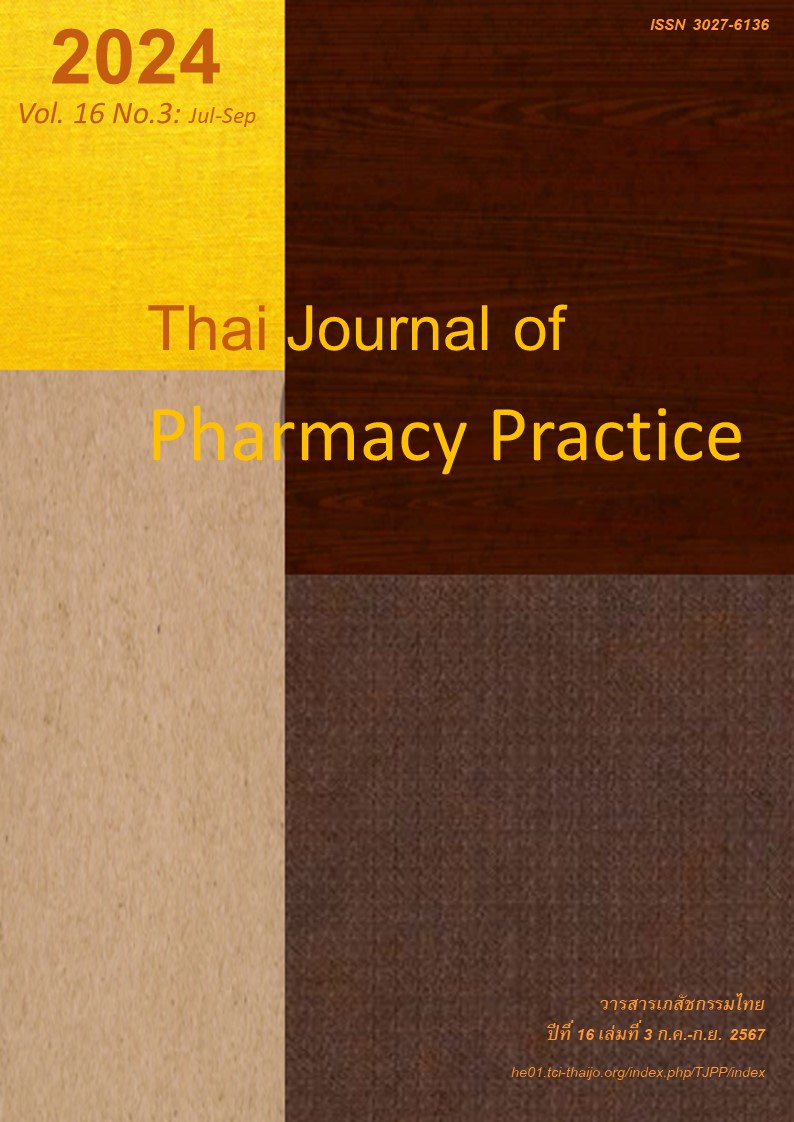ปัจจัยที่มีผลต่อความร่วมมือในการใช้ยาของผู้ป่วยความดันโลหิตสูงใน โรงพยาบาลส่งเสริมสุขภาพตำบลห้วยสัตว์ใหญ่ อำเภอหัวหิน จังหวัดประจวบคีรีขันธ์
Main Article Content
บทคัดย่อ
วัตถุประสงค์: เพื่อหาปัจจัยที่มีผลต่อความร่วมมือในการใช้ยาของผู้ป่วยโรคความดันโลหิตสูงในโรงพยาบาลส่งเสริมสุขภาพตำบล (รพ.สต.) ห้วยสัตว์ใหญ่ อำเภอหัวหิน จังหวัดประจวบคีรีขันธ์ วิธีการ: การวิจัยครั้งนี้เป็นการศึกษาแบบภาคตัดขวาง โดยเก็บข้อมูลจากผู้ป่วยความดันโลหิตสูงทุกคนที่มารับบริการที่ รพ.สต. ห้วยสัตว์ใหญ่ ในเดือนสิงหาคม พ.ศ.2564 การประเมินความร่วมมือในการใช้ยาใช้แบบวัดความร่วมมือในการใช้ยาสำหรับชาวไทย (Medication Adherence Scale in Thais หรือ MAST©) การประเมินความเครียดของผู้ป่วยใช้แบบวัด SPST-20 (Suanprung Stress Test 20) การประเมินความรู้ในเรื่องโรคและยาและแรงสนับสนุนจากสังคมใช้แบบประเมินที่ผู้วิจัยพัฒนาขึ้นจากการทบทวนวรรณกรรม การศึกษาใช้การวิเคราะห์ถดถอยลอจิสติกแบบทวิเพื่อทำนายความร่วมมือในการใช้ยาโดยมีตัวแปรอิสระ คือ เพศ อายุ การศึกษา อาชีพ ความสามารถในการควบคุมความดันโลหิต โรคร่วม และระยะเวลาการเป็นโรคความดันโลหิตสูง ความเครียด ความรู้เรื่องโรคและยารักษาความดันโลหิตสูง และแรงสนับสนุนทางสังคม ผลการศึกษา: ผู้ร่วมการวิจัยเป็นผู้ป่วย 79 คน อายุเฉลี่ย 65.56±10.99 ปี เป็นเพศหญิงร้อยละ 75.95 ระยะเวลาเป็นโรคเฉลี่ย 7.68±4.12 ปี ตัวอย่างร้อยละ 79.75 ควบคุมระดับความดันโลหิตไม่ได้ คะแนนความรู้เฉลี่ย 11.47±2.22 คะแนน (จากคะแนนเต็ม 15) คะแนนแรงสนับสนุนทางสังคมเฉลี่ย 20.11±4.73 คะแนน (จากคะแนนเต็ม 25) คะแนนความเครียดเฉลี่ย 25.34±4.62 คะแนน (จากคะแนนเต็ม 100) คะแนนความร่วมมือในการใช้ยาเฉลี่ย 36.10±4.02 คะแนน (จากคะแนนเต็ม 40) ผู้ป่วยร้อยละ 78.5 มีระดับความร่วมมือในการใช้ยาในระดับที่เพียงพอ ผู้ป่วยความดันโลหิตสูงเพศชายมีโอกาสที่จะมีความร่วมมือในการใช้ยาที่เพียงพอมากกว่าเพศหญิง 8.6 เท่าตัวซึ่งมีนัยสำคัญทางสถิติ (95%CI ของ OR หรือ odds ratio = 1.02-72.48; P = 0.048) และคะแนนความรู้เรื่องโรคความดันโลหิตสูงที่เพิ่มขึ้น 1 หน่วย สัมพันธ์กับโอกาสการมีความร่วมมือในการใช้ยาที่เพียงพอที่เพิ่มขึ้น 1.35 เท่าตัว (95%CI ของ OR = 1.02-1.77; P = 0.034) การวิเคราะห์พบ pseudo R2 = 0.12 (P=0.007) สรุป: ผู้ป่วยโรคความดันโลหิตสูง รพ.สต.ห้วยสัตว์ใหญ่ อำเภอหัวหิน จังหวัดประจวบคีรีขันธ์ที่เป็นเพศชายและที่มีคะแนนความรู้ที่สูงขึ้น มีโอกาสพบว่ามีความร่วมมือในการใช้ยาสูงกว่าเพศหญิงและผู้ที่มีคะแนนที่ต่ำกว่าอย่างมีนัยสำคัญทางสถิติ
Article Details

อนุญาตภายใต้เงื่อนไข Creative Commons Attribution-NonCommercial-NoDerivatives 4.0 International License.
ผลการวิจัยและความคิดเห็นที่ปรากฏในบทความถือเป็นความคิดเห็นและอยู่ในความรับผิดชอบของผู้นิพนธ์ มิใช่ความเห็นหรือความรับผิดชอบของกองบรรณาธิการ หรือคณะเภสัชศาสตร์ มหาวิทยาลัยสงขลานครินทร์ ทั้งนี้ไม่รวมความผิดพลาดอันเกิดจากการพิมพ์ บทความที่ได้รับการเผยแพร่โดยวารสารเภสัชกรรมไทยถือเป็นสิทธิ์ของวารสารฯ
เอกสารอ้างอิง
Division of Non-communicable Diseases. Number and mortality rate with 5 NCD 2016–2020 [online]. 2021 [cited Aug 20, 2021].Available from: www.thai ncd.com/2016/mission/documents-detail.php?id=14 480&tid=32&gid=1-020.
Thai Hypertension Society. 2019 Thai guidelines on the treatment of hypertension [online]. 2019 [cited Aug 20, 2021].Available from: http://www.thaihyper tension.org/guideline.html
Uchmanowicz B, Chudiak A, Uchmanowicz I, Rosińc zuk J, Froelicher ES. Factors influencing adherence to treatment in older adults with hypertension. Clin Interv Aging 2018; 13: 2425–41.
Bunyatnopparat K, Limpawattana P. Factor associated with medication adherence in older patients with chronic diseases of Dongluang hospital. KKU Journal of Medcine 2019; 5: 40-9.
Puanglai K, Jarupaktranonth C, Changsirikulchai S, Janma J, Chuemongkon W. Stress and medication adherence among continuous ambulatory peritoneal dialysis patients. Srinagarind Medical Journal 2020; 35: 287–95.
Jitautai W. Factors influencing medication adherence in hypertensive patients without complications [master thesis]. Chonburi; Burapha University; 2021.
Mahatnirunkul S, Pumpaisalchai W, Tapanya P. The construction of Suanprung stress test for Thai population. Academic Psychiatry and Psychology Journal 1997; 13: 1-20.
Suphachamroon A, Lerkiatbundit S, Saengcharoen W. Validity and reliability of the medication adherence scale in Thais. Thai Journal of Pharmacy Practice 2018; 10: 607–19.
Jongwilaikasem K, Lerkiatbundit S. Development of the medication adherence scale for Thais (MAST). Thai Journal of Pharmacy Practice. 2021; 13: 17–30.
Puengdokmai P, Charoenkitkarn V, Pinyopasakul W, Sriprasong S, Dumavibhat C. Factors influencing medication adherence in hypertensive patients without complications. Princess of Naradhiwas University Journal 2016; 8: 16–26.
Rungsawang S. Factors related to polypharmacy medication adherence among older persons with chronic illness. Journal of Nursing, Siam University 2017; 18: 6–23.
Ernawati I, Lubada EI, Lusiyani R, Prasetya RA. Association of adherence measured by self-reported pill count with achieved blood pressure level in hypertension patients: a cross-sectional study. Clin Hypertens 2022; 28: 12. doi: 10.1186/s40885-022-00195-5.
Choi HY, Oh IJ, Lee JA, Lim J, Kim YS, Jeon TH, et al. Factors affecting adherence to antihyperten sive medication. Korean J Fam Med. 2018; 39: 325–32.
Pattanajak C. Medication adherence in elderly patients with chronic disease at Lad Pattana Health promoting hospital, Muang District, Mahasarakham province. Mahasarakham Hospital Journal. 2019; 16: 13–22.
Panthonglang W, Namphonkrang P, Duangsanjan W.Factors influencing the health behavior of uncontrolled hypertension patients. Songklanagarind Journal of Nursing 2018; 38: 152–65.


